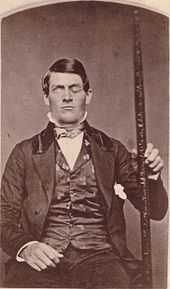Phineas Gage
Phineas P. Gage (* probably 9. July 1823 in Lebanon , New Hampshire ; † 21st May 1860 in San Francisco , California ) worked as a foreman at the American Railway Company Rutland & Burlington Railroad in Cavendish , Vermont , and suffered there at 13 September 1848 had a serious accident.
When he was detonated, an iron rod about 1.10 m long and 3 cm thick shot up through his skull from the bottom, creating a large wound canal. The bar entered the head below the left cheekbone and exited at the top of the head (lesion in the orbitofrontal and prefrontal cortex ). Gage remained conscious during the accident and was later able to report on the entire course of the accident. He survived the accident and the wounds healed, only his left eye was irreversibly destroyed by the accident.
Consequences of the accident
The accident of Phineas P. Gage is of great importance for neuroscientific research: According to his doctor John D. Harlow, he was physically restored after a few weeks, as well as his intellectual abilities (including perception , memory , intelligence , language ability ) and his motor skills were completely intact. In the period after the accident, however, Gage had noticeable personality changes . The level-headed, friendly and balanced fee turned into a childish, impulsive and unreliable person. This clinical picture is now known in neurology as frontal brain syndrome .
Gage suffered repeated epileptic seizures and fever attacks after the accident, lost consciousness after a violent seizure and never regained it after a series of other convulsions. He died on May 21, 1860. António Damásio is of the opinion that he fell victim to a status epilepticus .
exhumation
In 1867 the body was exhumed . The skull and the iron rod that was also buried at the time were exhibited in the Museum of Harvard Medical School . In 1994 the skull was scanned by Hanna Damásio at the University of Iowa and a brain that would fit into this skull was simulated on the computer. Using the holes in the skull, it was possible to determine which areas of the brain were damaged by the rod.
A photo showing Gage with an iron bar and a left eye blocked by paralysis of the upper eyelid was identified in 2009 after years of neglect in the possession of a historical photography collector in Maryland, USA.
gallery
The accident occurred during the construction of this cut (or a similar one in the immediate vicinity) for the Rutland & Burlington Railroad
literature
- António Damásio : Descartes' error - feeling, thinking and the human brain , Munich: List, 1994, ISBN 3-471-77342-8
- Hanna Damásio u. a .: The return of Phineas Gage: clues about the brain from the skull of a famous patient . In: Science 264 (5162) . 1994, p. 1102-1105 .
- Michael Gazzaniga , R. Ivry R., G. Mangun: Cognitive Neuroscience - The biology of the mind . Cape. 13 (Emotion), 2002.
Web links
- Documentation about the Phineas Gage case (episode 25; viewable online with subtitles)
- 13.09.1848 - Accident of the railway worker Phineas Gage WDR ZeitZeichen (podcast).
Individual evidence
- ↑ Ronald D. Gerste : The portrait of Phineas Gage . In: Neue Zürcher Zeitung . September 9, 2009 ( nzz.ch ).
| personal data | |
|---|---|
| SURNAME | Gage, Phineas |
| ALTERNATIVE NAMES | Gage, Phineas P. |
| BRIEF DESCRIPTION | American railroad worker whose injury contributed to neuroscience knowledge |
| DATE OF BIRTH | July 9, 1823 |
| PLACE OF BIRTH | Lebanon , New Hampshire |
| DATE OF DEATH | May 21, 1860 |
| Place of death | San Francisco , California |







